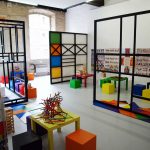Children’s play with sensory-rich, loose part materials can be an important part in creative learning. How these materials are spatially arranged may also dramatically influence how a child takes up and explores them.
Below are three practical tips for arranging materials to support children’s imagination and curiosity. I have put these together based on my own experience working as an artist and educator with young children.
It would be great to hear what others find useful when laying out materials for children so please comment below!

-
Layout materials to encourage social interactions
Vygotsky talks about the importance of social interactions in facilitating learning amongst groups of people (Vygotsky, 1980). As a child’s peers, teacher or parents may have more advanced understandings or abilities in relation to a particular skill, concept or task, a child’s interactions with them may allow for new knowledge to be produced. Social interactions between groups of people may encourage collective problem solving and group conceptual exploration. Social interactions may be verbal (through discussions) or observational (through watching others).
Arranging materials in a large, communal area such as a table, rug or outdoor space can encourage children to interact with different peers and adults. Furthermore, creating opportunities for children to work together on a joint problem may also encourage learning from multiple perspectives.
An example of this could be setting up a painting activity on a large 5m x 2m sheet of paper instead of giving children individual pieces of paper to work on. Or if you want children to make individual artworks, layout the workstations in a way that children can watch and interact with others.
-
Present familiar materials in unfamiliar ways
A giant log inside a classroom. A bunch of flowers on a light table. Musical instruments in a forest. A newspaper sculpture in a garden. Thinking creatively about the context that materials are presented in may encourage children to explore and experiment with them in dynamic ways. The unusual arrangement may also draw new aesthetic perspectives to the material, encouraging different learning pathways.
For example, children may play with a tree branch presented on a table indoors differently to how they may play with the same branch in a park.
-
Select a flexible arrangement that allows for transformations
Flexibility has been flagged as a critical consideration in the spatial and material design of children’s learning environments (Dudek, 2005). Children’s ability to adapt, modify, construct, destroy and reconstruct the spatial arrangement of an environment may allow them to take make it more personally meaningful over time. Allowing for materials to be moved around and change form is an important part of designing for flexibility.
This could be done in many ways. For example, the environment could start very simple with just one material. Different materials and spatial arrangements could then be added in response to children’s play.
Selecting materials that are open-ended, and can transform over time – like clay, paint or natural materials – can encourage children’s experimentation over an extended period of time. Tools, such as rollers and hammers also allow children to transform a material in different ways.
Finally, having an experimental mindset is the most important quality an educator can have in exploring the arrangement of materials! This way of thinking prevents materials from being used in fixed and formatted ways in children’s lives.
It is also important to note that an arrangement that worked well in one activity may go pear-shaped in the next.
Happy experimenting!!
If you need more inspiration for laying out materials, check out my Pinterest page.
References
Dudek, M (2005). Children’s Spaces. London: Routledge.
Vygotsky, L (1980). Mind in society: The development of higher psychological processes. Cambridge, MA: Harvard University Press.
Related posts
What is the role of materials in children’s creative learning through art?
4 organisations exploring materials in innovative ways
Children’s creative learning through the art of Sheila Hicks





3 Comments
Just brilliant.
Brilliant ideas were given in this article and I am really appreciated by reading it. For the special COVID-19 period, I think some outdoor activities may better to bring in to families and children. These ideas gave me a strong idea that I could share with parents.
So glad to hear you have got some inspiration from the post. I think a lot of these tips could be adapted for an outdoor/COVID-era! Good luck